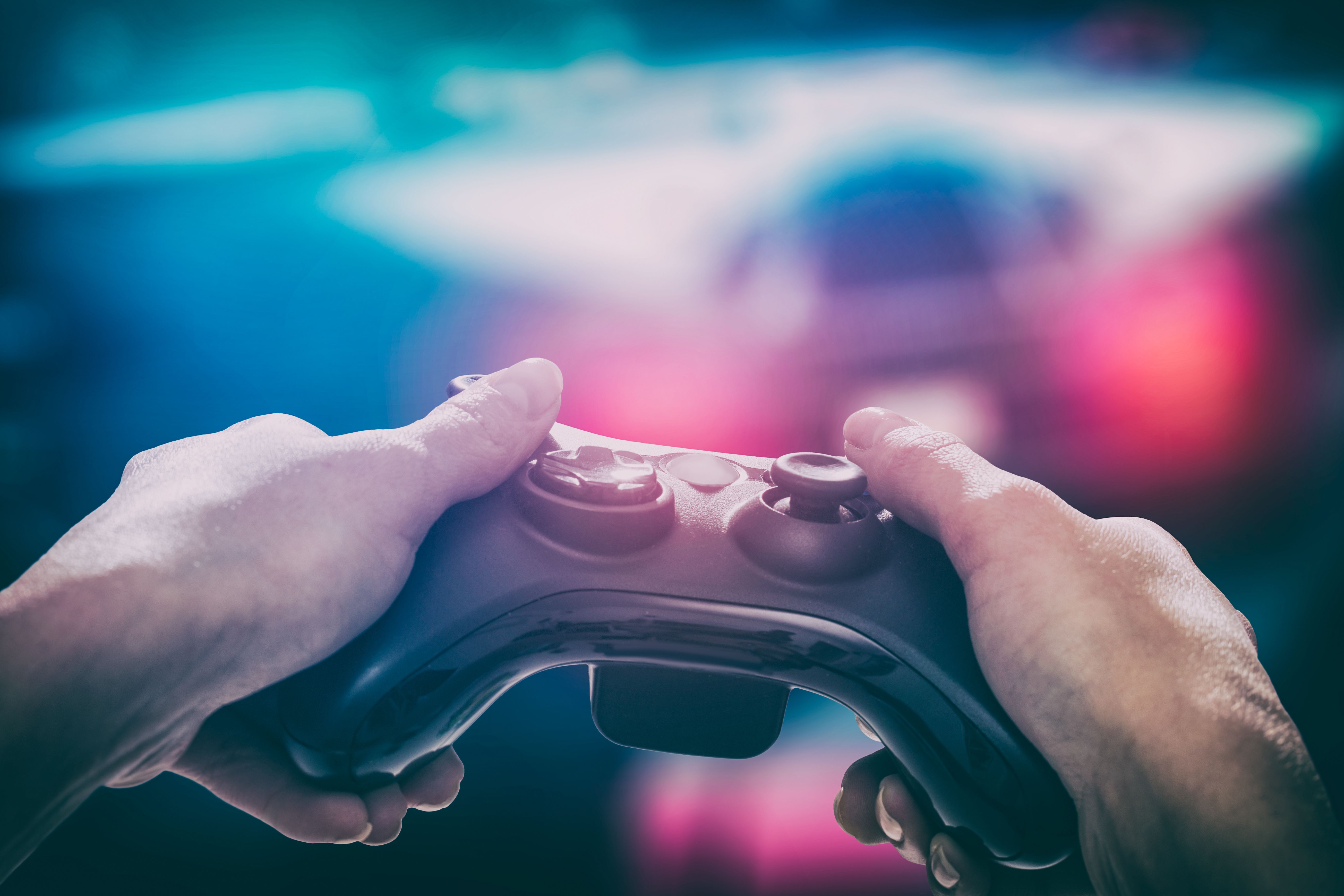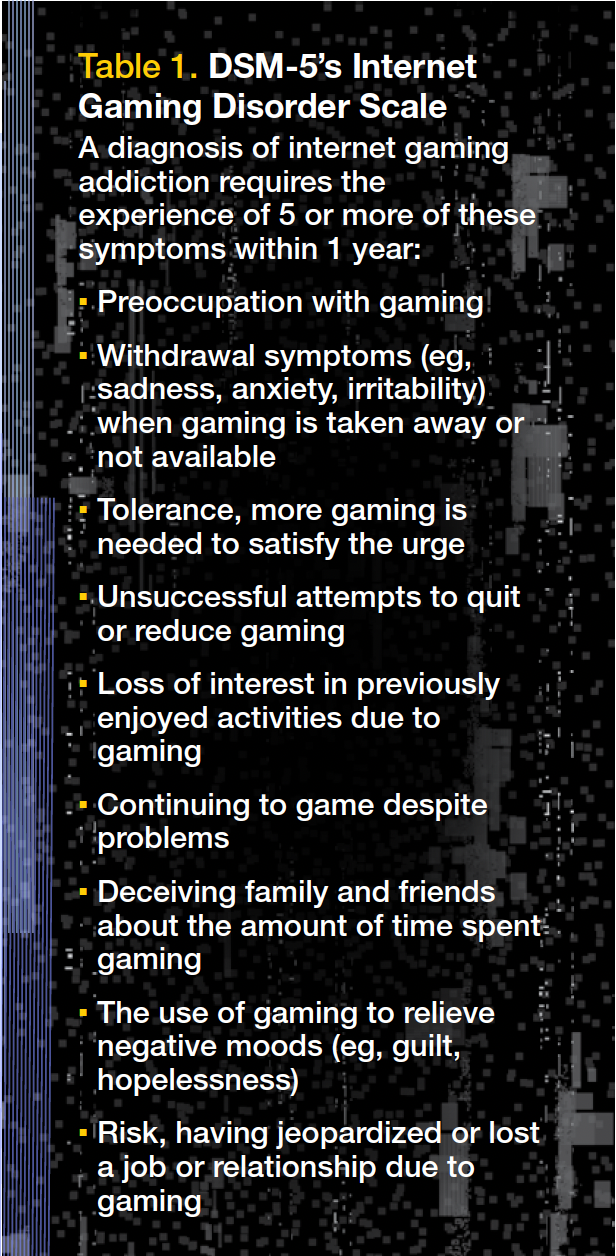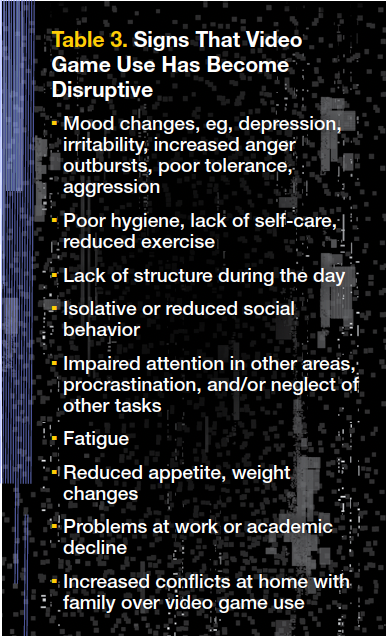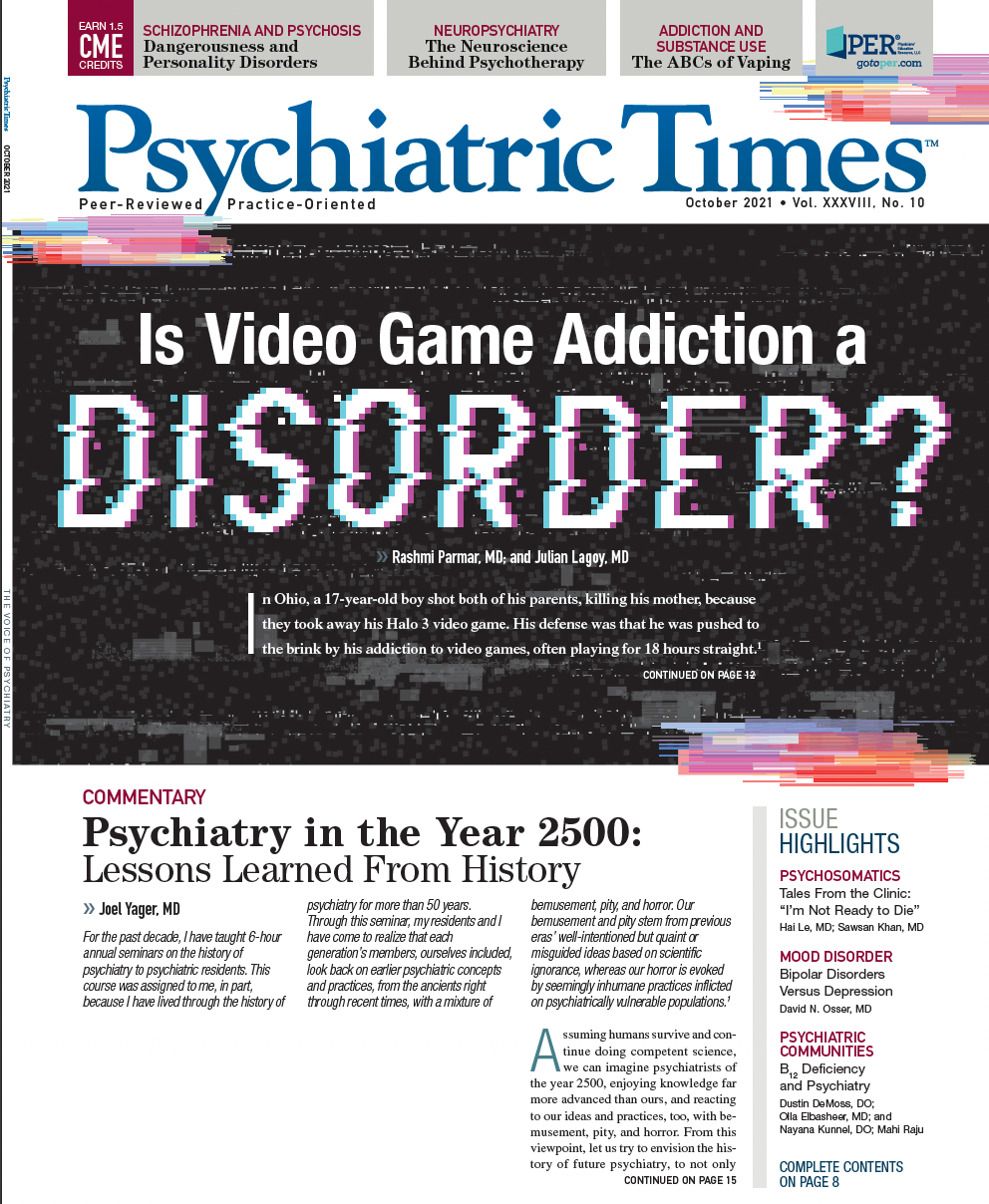Publication
Article
Psychiatric Times
Is Video Game Addiction a Disorder?
Author(s):
Is gaming dangerous? A study found 10% of video game players exhibited pathological behavior.
REDPIXEL/AdobeStock

In Ohio, a 17-year-old boy shot both of his parents, killing his mother, because they took away his Halo 3 video game. His defense was that he was pushed to the brink by his addiction to video games, often playing for 18 hours straight.1
This tragic story joins others from around the world. In South Korea, a couple was arrested for being so obsessed with video games that their infant daughter died of malnutrition.2 As Korean internet gaming cafes grew in popularity, so did stories of players who wore diapers just so they could avoid taking bathroom breaks.2 Using the results of a survey of more than 2000 South Korean middle school students, close to 6% were classified as having a gaming disorder, and another 8% were considered to be at high risk for the disorder.3
In response to statistics like these, the World Health Organization (WHO) in 2018 officially included internet gaming disorder (ICD) in International Classification of Diseases, 11th Edition, noting that the disorder resulted in “marked distress or significant impairment in personal, family, social, educational, or occupational functioning.” WHO further noted other associated health concerns, including insufficient physical activity, poor diet, problems with eyesight and hearing, musculoskeletal problems, sleep deprivation, aggressive behavior, and depression, as well as poor psychosocial functioning.4
Mental health providers in numerous countries, including South Korea and China, welcomed WHO’s decision, saying it formalized a way to better understand the problem and support patients. In the United States, however, the American Psychiatric Association (APA) has been hesitant to label gaming addiction as a psychiatric disorder. So far, gambling is the only behavioral addiction identified as a disorder by the APA; it was added as a DSM-5 disorder in 2013.
Looking at Gaming Addiction

Only 0.3% to 1% of the worldwide population qualifies for a diagnosis of acute IGD, according to a 2017 international survey.5 A 2020 American Psychological Association survey of 214 scholars revealed a lack of consensus on gaming addiction.6 About 49.7% agreed with the DSM-5 criteria, and 56.5% supported WHO’s disorder diagnosis. Similarly, 60.8% of scholars agreed that pathological video game use could be a mental health problem, but 30.4% were skeptical.6
Clearly, opinions differ, contributing to ongoing confusion and making it difficult for psychiatrists to accurately diagnose and address symptoms.
Growing Popularity or Problem?
The earliest video game dates back to 1940, when an electromechanical machine was introduced at the New York World’s Fair. Public arcades remained the most popular places for gaming until the 1970s and 1980s, when Atari’s new video computer system brought games into homes. Then, video games found a new niche online with the rise of the internet, and it has evolved even further with mobile phones, which makes it easy to play anywhere, anytime. Today, the array of video game genres is vast, including role playing, action- adventure, first-person shooters, and strategy.
As a result, sales of video game products in the United States have swelled over the years. In 2020, consumers spent $57 billion on video games, beating 2019 sales by 27%,7 and the trend continues, with Americans spending $14.92 billion in the first quarter of 2021—a 30% increase over the first quarter of 2020.8 Globally, early 2020 projections were exceeded by $15.6 billion to $174.9 billion in revenues, thanks, in part, to the COVID-19 pandemic. Sales show no signs of stopping: Projections of 2023 sales are more than $217 billion.9
Table 1. DSM-5’s Internet Gaming Disorder Scale

Brigham Young University recently released results of a 6-year study, the longest of its kind, on the effects of video game play and the trajectories of addiction. The results show that 10% of video game players exhibited pathological behavior. Pathological behavior includes playing video games excessively, which increases risk of depression, aggression, shyness, and anxiety, and is associated with the worst outcomes over time. The researchers concluded that it is not a “one-size-fits-all disorder.” Players who displayed pathological behavior tended to be males with low levels of prosocial behavior. They exhibited the worst long-term outcomes, with higher risks of depression, aggression, shyness, problematic cell phone usage, and anxiety when compared with the nonpathological control group.10
In terms of assessment, DSM-5 has a 9-item IGD Scale used to assess symptoms of gaming addiction. Gaming must cause “significant impairment or distress” in several areas of a person’s life, with the expression of at least 5 symptoms within 1 year for a diagnosis (Table 1). Numerous risk factors are associated with IGD (Table 2).11
Other risk factors include underlying psychiatric illness, such as anxiety or depression, and certain personality traits such as neuroticism, anxiety, sensation-seeking behavior, aggression, and impulsivity.12 Those who play massively multiplayer online role-playing games are also at increased risk, compared with gamers who do not.13 People with severe attention-deficit/hyperactivity disorder (ADHD) symptoms, compared with those with less severe ADHD symptoms, are more at risk of developing video game addiction and suffering its negative consequences.14
Table 2. Risk Factors Associated With IGD

How Video Games Affect the Brain
A 2017 systematic review of 116 articles linked video game use to several structural and functional brain changes, involving attention, cognitive control, visuospatial skills, cognitive workload, and reward processes.15
Compared with nonplayers, gamers were found to have improved attention and visuospatial skills, likely due to increased blood flow and volumetric changes observed in the dorsolateral prefrontal cortex. Researchers also found that video game play is closely tied to the brain’s reward system and involves mechanisms related to impulsivity and loss of control. Gamers had increased activation of several areas in the cortical ventral basal ganglia circuit, a prime network that influences reward-seeking behavior. The hippocampus, parahippocampus, and amygdala, which link emotions and memory to game-related cues, were also involved.15
The review noted negative outcomes associated with video game play, such as reduced recruitment in the anterior cingulate cortex, which can negatively affect attention. Exposure to violence in video games was shown to lower activity in the dorsolateral prefrontal cortex, causing behavioral inhibition, negative effects on social information processing, delays in development of certain brain areas, and lower verbal IQ.15
Other studies have noted the impact of video games on the release of dopamine, the neurotransmitter associated with pleasure, learning, attention, reinforcement, and sensorimotor integration. For example, results of a 1998 study using radioligand and positron emission tomography (PET) scans found that dopamine levels were increased in the ventral striatum, which influences motivation and reward.16 Similarly, results of a 2011 study of 154 adolescents, all aged 14 years, leveraged functional MRI scans and found that frequent gamers had increased grey matter in the left ventral striatum of their brains, an effect similar to that present in the brains of gambling addicts.17 The study authors suggested that changes in dopamine receptors and brain reward pathways over time could cause players, particularly addicts, to build up a tolerance and experience less pleasure. This effect is similar to substance abuse addiction, as both exhibit reduced dopamine responses to stimuli.18
In addition to its effects on the brain, excessive gaming is associated with a variety of negative psychosocial effects. Studies have found that video game addicts tend to have poorer mental health and cognitive functioning, including poorer impulse control and more ADHD symptoms when compared with control groups. They also display increased emotional difficulties, such as depression and anxiety, feel more socially isolated, and are more likely to report symptoms indicative of problematic use with internet pornography.19
Results of a 2019 study in Germany showed a medium-sized positive correlation of potential problematic gaming with the presence of impaired psychological functioning; symptoms included depression, anxiety, and hostility. There was also a connection to maladaptive coping mechanisms (eg, self-blame, behavioral disengagement, denial, acceptance, substance use, self-distraction, and venting), overall negative affect, poor self-esteem, preference for solitude, and poor school performance. However, the authors cautioned about establishing causation, given that it was a cross-sectional study, and also warned that psychological dysfunction can be a cause or an effect of pathological gaming.20
Aggressive Behavior
How video games influence aggressive behavior has been hotly debated for decades. Concerns that violent video games such as Mortal Kombat and Night Trap could increase aggression in children played out in US Congressional hearings from 1993 to 1994. These led to the creation of the Entertainment Software Association, a trade group that created a standardized rating system of violence in video games.
Research conclusions are also divided on the topic of aggression. An article in the Journal of Personality and Social Psychology reviewed 2 studies and concluded that video games provided a dangerous medium for adopting aggressive solutions to conflicts. Video games, the authors wrote, caused short-term cognitive changes in the brain by priming aggressive thoughts. Long-term effects were created by reapplying aggression-related scripts learned during play time to real-life scenarios. Because players got to practice aggressive moves in real-time play, the authors concluded that playing violent video games was more dangerous than watching television or film violence.21
Authors of a 2019 study, however, countered this argument and found that no tipping point was associated with the engagement of a violent video game and an increase in aggressive behavior.22
Although opinions and research conclusions remain divided, a clear constant remains: Males are generally more likely than females to develop video game addictions.11 Gender differences may also play a role, particularly as it relates to anxiety during late adolescence. Although it is hard to generalize results due to the limited sample, results of a study suggested that boys who played video games experienced the least anxiety, while girls had the most, conditions that were exacerbated when playing with others.23 Possible reasons could be that boys are more likely than girls to make friends online, feel more connected to friends during play, and use video games to engage with friends.23
Results of another study indicated that internet gaming addiction seemed to shorten the length of leukocyte telomeres in adolescent Korean males, a result that could be attributed to changes in autonomic functions, such as catecholamine levels.24 Telomeres are genetic components that act as markers of cellular aging and are influenced by many factors, such as lifestyle changes and stress levels. Shorter telomere length is associated with increased pace of aging and increased incidence of diseases over time.
The Scope of the Problem
In 2017, a group of scholars wrote an open debate paper cautioning WHO against listing video game addiction as a disorder, as it could leave the proverbial door wide open to pathologizing other conditions, such as addictions to sex and food.25 Video game addiction rates are generally low, they argued, and there was a lack of consensus on the addiction’s symptoms and assessment. Criteria used to support the diagnosis relied too heavily on benchmarks for substance abuse and gambling disorders, they wrote. The scholars claimed that this distinction would shift the focus of video game addiction research to that of a confirmatory approach, rather than an exploratory one. They also cautioned that the label of disorder would create a moral panic and could trigger premature diagnoses, in addition to creating a stigma for children and youth who play video games as “part of a normal, healthy life.”
Although individuals in China and South Korea see IGD as a dangerous and growing problem, it does not seem to attract the same concern in the United States and elsewhere around the world. Much of this difference in perspective could come down to simple cultural differences. In China, professional esports players train upward of 14 hours a day for a chance to compete in arenas like the League of Legends world championships, where they can earn hundreds of thousands of dollars.26 In South Korea, watching esports competitions is more popular than watching other kinds of television programs. For many individuals raised in working-class families in South Korea, a nation in which access to higher education is intensely competitive, the idea of going professional serves as a way to escape their circumstances.27
Perhaps the stakes are not as high in the United States, where passion for the games may be among the strongest motivations to play. According to article authors writing on behalf of the American Psychological Association, 97% of children and adolescents aged 2 to 17 in the United States play video games for at least 1 hour a day. They noted that playing video games could improve cognitive skills, problem-solving abilities, mood, resilience, motivation, social skills, and overall well-being.28
A recent study by researchers at the University of Oxford, collaborating with 2 video game companies, surveyed more than 3270 players in the United States, United Kingdom, and Canada to measure their well-being, self-reported play, and motivational experiences during play.29 They found that players genuinely enjoyed playing the games, which had a significant positive impact on a player’s well-being. Further, the findings were aligned with past research results suggesting that people whose psychological needs are not being met in the real world might report negative well-being from play.
Studies have also shown that the length of play time and the type of video game have an impact on the game’s negative or positive effect. Games that featured more online social interaction resulted in fewer problematic gaming symptoms. Males playing nonsocial games appeared to have more social anxiety. Females who played social games had less social anxiety and loneliness but exhibited lower self-esteem than their male counterparts.30
Of note, interest is growing in using video games to treat a range of mental health conditions in youth and adults, such as ADHD, depression, and posttraumatic stress disorder.
Treating Video Game Addiction
In some cases, classifying video game addiction as a disorder could be useful, even if only a small percentage of people experience it. Such a distinction would allow clinicians to detect and treat other coexisting conditions, such as depression, anxiety, and substance addiction.
When considering a potential problem with video games, clinicians should look for symptoms and signs that video game use has become disruptive (Table 3).
Table 3. Signs That Video Game Use Has Become Disruptive

Several treatment options are available to address video game addiction, including cognitive behavioral therapy, family therapy, motivational interviewing, and solution-focused therapy, as well as combinations of these. Additionally, Online Gamers Anonymous, a 12-step recovery program established in 2002, offers an approach to break addiction similar to that of Alcoholics Anonymous and Narcotics Anonymous.
For example, a study examined the efficacy of a 9-day self-discovery camp for adolescents that included 14 cognitive behavioral therapy sessions, 8 personal counseling sessions, 3 medical lectures, a gaming workshop, engagement in positive gaming activities, and abstinence from games during the stay.31 Researchers found that participation in this camp led to decreased gaming time at a 3-month follow-up and that age of onset of IGD and problem recognition were correlated.
Bupropion, a medication commonly used to treat depression and ADHD, has shown some positive effect in treating symptoms of video game addiction. Study results have shown some benefit from treating comorbid video game addiction and ADHD with methylphenidate.32 Unfortunately, these results highlight the paucity of well-designed treatment outcome studies, with limited evidence for the drugs’ effectiveness. Additional studies, ones with better design, are needed before these medications are FDA approved.
Dr Parmar is a double board-certified adult and child psychiatrist with Community Psychiatry based in Newark, CA. Dr Lagoy is a staff psychiatrist at Community Psychiatry in San Jose, CA.
References
1. Teen who killed over video game gets 23 years. NBC News. June 16, 2009. Accessed June 10, 2021. https://www.nbcnews.com/id/wbna31387876
2. Kim V. He played for 72 hours straight: South Korea wrestles with video game addiction. Los Angeles Times. October 17, 2019. Accessed June 10, 2021. https://www.latimes.com/world-nation/story/2019-10-17/south-korea-video-game-addiction-mental-health
3. Yu H, Cho J. Prevalence of internet gaming disorder among Korean adolescents and associations with non-psychotic psychological symptoms, and physical aggression. Am J Health Behav. 2016;40(6):705-716.
4. Addictive behaviours: gaming disorder. World Health Organization. September 14, 2018. Accessed June 10, 2021. https://www.who.int/news-room/q-a-detail/addictive-behaviours-gaming-disorder
5. Przybylski AK, Weinstein N, Murayama K. Internet gaming disorder: investigating the clinical relevance of a new phenomenon. Am J Psychiatry. 2017;174(3):230-236.
6. Ferguson CJ, Colwell J. Lack of consensus among scholars on the issue of video game “addiction.” Psychol Popular Media. 2020;9(3):359-366.
7. The NPD Group: fourth quarter 2020 U.S. consumer spending on video game products increased 26% while annual spend gained 27% compared to 2019. News release. February 1, 2021. Accessed June 10, 2021. https://www.npd.com/news/press-releases/2021/the-npd-group-fourth-quarter-2020-u-s-consumer-spending-on-video-game-products-increased-26-while-annual-spend-gained-27-compared-to-2019/
8. The NPD Group: first quarter 2021 U.S. consumer spending on video game products increased 30%. News release. April 29, 2021. Accessed June 10, 2021. https://www.npd.com/news/press-releases/2021/the-npd-group-first-quarter-2021-u-s-consumer-spending-on-video-game-products-increased-30/
9. Wijman T. Global game revenues up an extra $15 billion this year as engagement skyrockets. Newzoo. November 4, 2020. Accessed June 10, 2021. https://newzoo.com/insights/articles/game-engagement-during-covid-pandemic-adds-15-billion-to-global-games-market-revenue-forecast/
10. Coyne SM, Stockdale LA, Warburton W, et al. Pathological video game symptoms from adolescence to emerging adulthood: a 6-year longitudinal study of trajectories, predictors, and outcomes. Dev Psychol. 2020;56(7):1385-1396.
11. Rho MJ, Lee H, Lee T-H, et al. Risk factors for internet gaming disorder: psychological factors and internet gaming characteristics. Int J Environ Res Public Health. 2017;15(1):40.
12. Mehroof M, Griffiths MD. Online gaming addiction: the role of sensation seeking, self-control, neuroticism, aggression, state anxiety, and trait anxiety. Cyberpsychol Behav Soc Netw. 2010;13(3):313-316.
13. Kuss DJ, Louws J, Wiers RW. Online gaming addiction? Motives predict addictive play behavior in massively multiplayer online role-playing games. Cyberpsychol Behav Soc Netw. 2012;15(9):480-485.
14. Mathews CL, Morrell HER, Molle JE. Video game addiction, ADHD symptomatology, and video game reinforcement. Am J Drug Alcohol Abuse. 2019;45(1):67-76.
15. Palaus M, Marron EM, Viejo-Sobera R, Redolar-Ripoll D. Neural basis of video gaming: a systematic review. Front Hum Neurosci. 2017;11:248.
16. Koepp MJ, Gunn RN, Lawrence AD, et al. Evidence for striatal dopamine release during a video game. Nature. 1998;393(6682):266-268.
17. Kühn S, Romanowski A, Schilling C, et al. The neural basis of video gaming. Transl Psychiatry. 2011;1(11):e53.
18. Weinstein AM. Computer and video game addiction—a comparison between game users and non-game users. Am J Drug Alcohol Abuse. 2010;36(5):268-276.
19. Stockdale L, Coyne SM. Video game addiction in emerging adulthood: cross-sectional evidence of pathology in video game addicts as compared to matched healthy controls. J Affect Disord. 2018;225:265-272.
20. von der Heiden JM, Braun B, Müller KW, Egloff B. The association between video gaming and psychological functioning. Front Psychol. 2019;10:1731.
21. Anderson CA, Dill KE. Video games and aggressive thoughts, feelings, and behavior in the laboratory and in life. J Pers Soc Psychol. 2000;78(4):772-790.
22. Przybylski AK, Weinstein N. Violent video game engagement is not associated with adolescents’ aggressive behaviour: evidence from a registered report. R Soc Open Sci. 2019;6(2):171474.
23. McCauley Ohannessian C. Video game play and anxiety during late adolescence: the moderating effects of gender and social context. J Affect Disord. 2018;226:216-219.
24. Kim N, Sung JY, Park JY, et al. Association between internet gaming addiction and leukocyte telomere length in Korean male adolescents. Soc Sci Med. 2019;222:84-90.
25. Aarseth E, Bean AM, Boonen H, et al. Scholars’ open debate paper on the World Health Organization ICD-11 Gaming Disorder proposal. J Behav Addict. 2017;6(3):267-270.
26. Wescott B, Fang N. They train 14 hours a day, 7 days a week, chasing million-dollar paydays. Meet China’s new breed of esports athletes. CNN Business. December 31, 2019. Accessed June 10, 2021. https://www.cnn.com/2019/12/30/tech/chinese-gamers-competition-intl-hnk/index.html
27. Lee J. Why so many esports pros come from South Korea. Wired. October 27, 2020. Accessed June 10, 2021. https://www.wired.com/story/korean-esports-gaming-class-culture/
28. Granic I, Lobel A, Engels RCME. The benefits of playing video games. Am Psychol. 2014;69(1):66-78.
29. Johannes N, Vuorre M, Przybylski AK. Video game play is positively correlated with well-being. Royal Society Open Science. 2021;8(2):202049.
30. Colder Carras M, Van Rooij AJ, Van de Mheen D, et al. Video gaming in a hyperconnected world: a cross-sectional study of heavy gaming, problematic gaming symptoms, and online socializing in adolescents. Comput Human Behav. 2017;68:472-479.
31. Sakuma H, Mihara S, Nakayama H, et al. Treatment with the Self-Discovery Camp (SDiC) improves internet gaming disorder. Addict Behav. 2017;64:357-362.
32. Zajac K, Ginley MK, Chang R, Petry NM. Treatments for internet gaming disorder and internet addiction: a systematic review. Psychol Addict Behav. 2017;31(8):979-994. ❒






